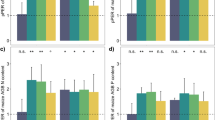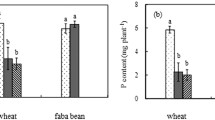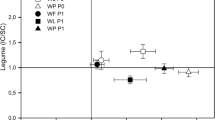Abstract
Less attention has been given to soil enzymes that contribute to beneficial rhizosphere interactions in intercropping systems. Therefore, we performed a field experiment by growing faba bean, lupine, and maize in mono and mixed cultures in a moderately fertile soil. We measured shoot biomass and the kinetic parameters (maximal velocity (Vmax) and Michaelis-constant (Km)) of three key enzymes in the rhizosphere: Leucine-aminopeptidase (LAP), β-1,4-N-acetylglucosaminidase (NAG), and phosphomonoesterase (PHO). Faba bean benefitted in mixed cultures by greater shoot biomass production with both maize and lupine compared to its expected biomass in monoculture. Next, LAP and NAG kinetic parameters were less responsive to mono and mixed cultures across the crop species. In contrast, both the Vmax and Km values of PHO increased in the faba bean rhizosphere when grown in mixed cultures with maize and lupine. A positive relative interaction index for shoot P and N uptake for faba bean showed its net facilitative interactions in the mixed cultures. Overall, these results suggest that over-productivity in intercropping is crop-specific and the positive intercropping effects could be modulated by P availability. We argue that the enzyme activities involved in nutrient cycling should be incorporated in further research.

Article PDF
Similar content being viewed by others
Avoid common mistakes on your manuscript.
References
Ai, C., Liang, G., Sun, J., Wang, X., Zhou, W., 2012. Responses of extracellular enzyme activities and microbial community in both the rhizosphere and bulk soil to long-term fertilization practices in a fluvo-aquic soil. Geoderma 173–174, 330–338.
Amrhein, V., Greenland, S., Mcshane, B., 2019. Retire statistical significance. Nature 567, 305–307.
Armas, C., Ordiales, R., Pugnaire, F.I., 2004. Measuring plant interactions: A new comparative index. Ecology 85, 2682–2686.
Badalucco, L., Nannipieri, P., 2007. Nutrient Transformation in the Rhizosphere. In: Pinton, R., Varanini, Z., Nannipieri, P., eds. The Rhizosphere: Biochemistry and Organic Substances at the Soil-plant Interface. CRC Press, Boca Raton, pp. 111–133.
Beier, S., Bertilsson, S., 2013. Bacterial chitin degradation-mechanisms and ecophysiological strategies. Frontiers in Microbiology 4, 1–12.
Bertness, M., Callaway, R.M., 1994. Positive interactions in communities. Trends in Ecology & Evolution 9, 191–193.
Blagodatskaya, E., Kuzyakov, Y., 2008. Mechanisms of real and apparent priming effects and their dependence on soil microbial biomass and community structure: Critical review. Biology and Fertility of Soils 45, 115–131.
Cheng, W., Kuzyakov, Y., 2005. Root effects on soil organic matter decomposition. In: Zobel, R.W., Wright, S.F., eds. Roots and Soil Management: Interactions between Roots and the Soil. John Wiley & Sons
Chung, H.G., Zak, D.R., Reich, P.B., Ellsworth, D.S., 2007. Plant species richness, elevated CO2, and atmospheric nitrogen deposition alter soil microbial community composition and function. Global Change Biology 13: 980–989.
Cong, W.F., Hoffland, E., Li, L., Janssen, B.H., van der Werf, W., 2015. Intercropping affects the rate of decomposition of soil organic matter and root litter. Plant and Soil 391, 399–411.
Dakora, F.D., Phillips, D.A., 2002. Root exudates as mediators of mineral acquisition in low-nutrient environments. Plant and Soil 245, 35–47.
De Nobili, M., Contin, M., Mondini, C., Brookes, P., 2001. Soil microbial biomass is triggered into activity by trace amounts of substrate. Soil Biology & Biochemistry 33, 1163–1170.
Dilly, O., Nannipieri, P., 2001. Response of ATP content, respiration rate and enzyme activities in an arable and a forest soil to nutrient additions. Biology and Fertility of Soils 34, 64–72.
Dissanayaka, D.M.S.B., Maruyama, H., Masuda, G., Wasaki, J., 2015. Interspecific facilitation of P acquisition in intercropping of maize with white lupin in two contrasting soils as influenced by different rates and forms of P supply. Plant and Soil 390, 223–236.
Dong, N., Tang, M.M., Zhang, W.P., Bao, X.G., Wang, Y., Christie, P., Li, L., 2018. Temporal differentiation of crop growth as one of the drivers of intercropping yield advantage. Science Reports 8, 3110.
Ehrmann, J., Ritz, K., 2013. Plant: Soil interactions in temperate multi-cropping production systems. Plant and Soil 376, 1–29.
Finzi, A.C., Abramoff, R.Z., Spiller, K.S., Brzostek, E.R., Darby, B.A., Kramer, M.A., Phillips, R.P., 2015. Rhizosphere processes are quantitatively important components of terrestrial carbon and nutrient cycles. Global Change Biology 21, 2082–2094.
Fontaine, S., Henault, C., Aamor, A., Bdioui, N., Bloor, J.M.G., Maire, V., Mary, B., Revaillot, S., Maron, P.A., 2011. Fungi mediate long term sequestration of carbon and nitrogen in soil through their priming effect. Soil Biology & Biochemistry 43, 86–96.
Gardner, W.K., Boundy, K.A., 1983. The acquisition of phosphorus by Lupinus albus L. IV. The effect of interplanting wheat and white lupin on the growth and mineral composition of the two species. Plant Soil 70, 391–402.
Gianfreda, L., 2015. Enzymes of importance to rhizosphere processes. Journal of Soil Science and Plant Nutrition 15, 283–306.
Hamer, U., Marschner, B., 2005. Priming effects in different soil types induced by fructose, alanine, oxalic acid and catechol additions. Soil Biology & Biochemistry 37, 445–454.
Holmgren, M., Scheffer, M., 2010. Strong facilitation in mild environments: The stress gradient hypothesis revisited. Journal of Ecology 98, 1269–1275.
Kassambara, A., 2019. ggpubr: ‘ggplot2’ Based Publication Ready Plots. R package version 0.2.4. https://CRAN.R-project.org/package = ggpubr.
Killham, K., Prosser, J.I., 2015. The Bacteria and Archaea, 4th ed. Elsevier Inc.
Kumar, A., Shahbaz, M., Blagodatskaya, E., Kuzyakov, Y., Pausch, J., 2018. Maize phenology alters the distribution of enzyme activities in soil: Field estimates. Applied Soil Ecology 125, 233–239.
Kumar, A., Shahbaz, M., Koirala, M., Blagodatskaya, E., Seidel, S.J., Kuzyakov, Y., Pausch, J., 2019. Root trait plasticity and plant nutrient acquisition in phosphorus limited soil. Journal of Plant Nutrition and Soil Science 182, 945–952.
Kuzyakov Y., 2002. Review: Factors affecting rhizosphere priming effects. 382–396
Lewandowski, S., 1987. Diohe’ko, the Three sisters in seneca life: implications for a native agriculture in the Finger Lakes region of New York State. Agriculture and Human Values 4, 76–93.
Li, B., Li, Y., Wu, H., Zhang, F.F., Li, C.J., Li, X.X., Lambers, H., Li, L., 2016. Root exudates drive interspecific facilitation by enhancing nodulation and N2 fixation. Proceedings of the National Academy of Sciences of the United States of America 113, 6496–6501
Li, H., Shen, J., Zhang, F., Marschner, P., Cawthray, G., Rengel, Z., 2010. Phosphorus uptake and rhizosphere properties of intercropped and monocropped maize, faba bean, and white lupin in acidic soil. Biology and Fertility of Soils 46, 79–91.
Li, L., Li, S., Sun, J., Zhou, L.L., Bao, X.G., Zhang, H.G., Zhang, F.S., 2007. Diversity enhances agricultural productivity via rhizosphere phosphorus facilitation on phosphorus-deficient soils. Proceedings of the National Academy of Sciences of the United States of America 104, 3–7
Li, L., Tilman, D., Lambers, H., Zhang, F., 2014. Plant diversity and overyielding: insights from belowground facilitation of intercropping in agriculture. New Phytologist 203, 63–69.
Li, L., Zhang, F., Li, X., Christie, P., Sun, J., Yang, S., Tang, C., 2003. Interspecific facilitation of nutrient uptake by intercropped maize and faba bean. Nutrient Cycling in Agroecosystems 65: 61–71.
Li, S.M., Li, L., Zhang, F.S., Tang, C., 2004. Acid phosphatase role in chickpea/maize intercropping. Annali di Botanica 94, 297–303.
Li, Y., Yu, C., Cheng, X., 2009. Intercropping alleviates the inhibitory effect of N fertilization on nodulation and symbiotic N2 fixation of faba bean. Plant and Soil volume 323, 295–308.
Ma, X., Mason-Jones, K., Liu, Y., Blagodatskaya, E., Kuzyakov, Y., Guber, A., Dippold, M.A., Razavi, B.S., 2019. Coupling zymography with pH mapping reveals a shift in lupine phosphorus acquisition strategy driven by cluster roots. Soil Biology & Biochemistry 135, 420–428.
Malkinson, D., Tielbörger, K., 2010. What does the stress-gradient hypothesis predict? Resolving the discrepancies. Oikos 119, 1546–1552.
Marschner, P., Crowley, D., Yang, C.H., 2004. Development of specific rhizosphere bacterial communities in relation to plant species, nutrition and soil type. Plant and Soil 261, 199–208.
Marx, M.C., Wood, M., Jarvis, S.C., 2001. A microplate fluorimetric assay for the study of enzyme diversity in soils. Soil Biology & Biochemistry 33, 1633–1640
Mason-jones, K., Kuzyakov, Y., 2017. Soil Biology & Biochemistry “Non-metabolizable” glucose analogue shines new light on priming mechanisms: Triggering of microbial metabolism. Soil Biology & Biochemistry 107, 68–76.
Meng, L., Zhang, A., Wang, F., Han, X., Wang, D., Li, S., 2015. Arbuscular mycorrhizal fungi and rhizobium facilitate nitrogen uptake and transfer in soybean/maize intercropping system. Frontiers in Plant Science 6, 1–10.
Nabel, M., Temperton, V.M., Poorter, H., Lücke, A., Jablonowski, N.D., 2016. Energizing marginal soils-The establishment of the energy crop Sida hermaphrodita as dependent on digestate fertilization, NPK, and legume intercropping. Biomass and Bioenergy 87, 9–16.
Nannipieri, P., Giagnoni, L., Renella, G., Puglisi, E., Ceccanti, B., Masciandaro, G., Fornasier, F., Moscatelli, M.C., Marinari, S., 2012. Soil enzymology: classical and molecular approaches. Biology and Fertility of Soils 48, 743–762.
Olander, L.P., Vitousek, P.M., 2000. Regulation of soil phosphatase and chitinase activity by N and P availability. Biogeochemistry 49, 175–190.
Peng, H., Chen, Y., Yan, Z., Han, W., 2016. Stage-dependent stoichiometric homeostasis and responses of nutrient resorption in Amaranthus mangostanus to nitrogen and phosphorus addition. Scientific Reports 6, 1–9.
Postma, J.A., Lynch, J.P., 2012. Complementarity in root architecture for nutrient uptake in ancient maize/bean and maize/bean/squash polycultures. Annali di Botanica 110, 521–534.
Rillig, M.C., Ryo, M., Lehmann, A., Aguilar-Trigueros, C.A., Buchert, S., Wulf, A., Iwasaki, A., Roy, J., Yang, G., 2019. The role of multiple global change factors in driving soil functions and microbial biodiversity. Science 366, 886–890.
Sinsabaugh, R.L., Shah, J.J.F., 2011. Ecoenzymatic stoichiometry of recalcitrant organic matter decomposition: The growth rate hypothesis in reverse. Biogeochemistry 102, 31–43.
Temperton, V.M., Mwangi, P.N., Scherer-Lorenzen, M., Schmid, B., Buchmann, N., 2007. Positive interactions between nitrogen-fixing legumes and four different neighbouring species in a biodiversity experiment. Oecologia 151, 190–205.
Tischer, A., Blagodatskaya, E., Hamer, U., 2015. Microbial community structure and resource availability drive the catalytic efficiency of soil enzymes under land-use change conditions. Soil Biology & Biochemistry 89, 226–237.
Tischer, A., Sehl, L., Meyer, U.N., Kleinebecker, T., Klaus, V., Hamer, U., 2019. Land-use intensity shapes kinetics of extracellular enzymes in rhizosphere soil of agricultural grassland plant species. Plant and Soil 437, 215–239.
Voisin, A.S., Salon, C., Munier-Jolain, N.G., Ney, B., 2002. Quantitative effects of soil nitrate, growth potential and phenology on symbiotic nitrogen fixation of pea (Pisum sativum L.). Plant and Soil 243, 31–42.
Wahbi, S., Maghraoui, T., Hafidi, M., Sanguin, H., Oufdou, K., Prin, Y., Duponnois, R., Galiana, A., 2016. Enhanced transfer of biologically fixed N from faba bean to intercropped wheat through mycorrhizal symbiosis. Applied Soil Ecology 107, 91–98.
Wasaki, J., Rothe, A., Kania, A., Neumann, G., Römheld, V., Shinano, T., Osaki, M., Kandeler, E., 2005. Root exudation, phosphorus acquisition, and microbial diversity in the rhizosphere of white lupine as affected by phosphorus supply and atmospheric carbon dioxide concentration. Journal of Environmental Quality 34, 2157–2166.
Weisskopf, L., Abou-Mansour, E., Fromin, N., Tomasi, N., Santelia, D., Edelkott, I., Neumann, G., Aragno, M., Tabacchi, R., Martinoia, E., 2006. White lupin has developed a complex strategy to limit microbial degradation of secreted citrate required for phosphate acquisition. Plant, Cell & Environment 29, 919–927.
Wen, Z., Li, H., Shen, J., Rengel, Z., 2017. Maize responds to low shoot P concentration by altering root morphology rather than increasing root exudation. Plant and Soil 416, 1–13.
Wen Z, Li H, Shen Q, Tang, X., Xiong, C., Li, H., Pang, J., Ryan, M.H., Lambers, H., Shen, J., 2019. Tradeoffs among root morphology, exudation and mycorrhizal symbioses for phosphorus-acquisition strategies of 16 crop species. New Phytologist 223, 882–895
Wezel, A., Casagrande, M., Celette, F., Vian, J.F., Ferrer, A., Peigné, J., 2014. Agroecological practices for sustainable agriculture. A review. Agronomy for Sustainable Development 34, 1–20.
Wickham, H., 2016. ggplot2: Elegant Graphics for Data Analysis. Springer-Verlag New York.
Xiao, Y., Li, L., Zhang, F., 2004. Effect of root contact on interspecific competition and N transfer between wheat and fababean using direct and indirect 15N techniques. Plant and Soil 262, 45–54.
Yu, C.B., Li, Y.Y., Li, C.J., Sun, J.H., He, X.H., Zhang, F.S., Li, L., 2010. An improved nitrogen difference method for estimating biological nitrogen fixation in legume-based intercropping systems. Biology and Fertility of Soils 46, 227–235.
Yu, R., Li, X., Xiao, Z., Lambers, H., 2020. Phosphorus facilitation and covariation of root traits in steppe species. New Phytologist 226, 1285–1298
Zhang, N.N., Sun, Y.M., Li, L., Wang, E.T., Chen, W.X., Yuan, H.L., 2010. Effects of intercropping and Rhizobium inoculation on yield and rhizosphere bacterial community of faba bean (Vicia faba L.). Biology and Fertility of Soils 46, 625–639.
Zhang, W.P., Liu, G.C., Sun, J.H., Fornara, D., Zhang, L.Z., Zhang, F. F., Li, L., 2017. Temporal dynamics of nutrient uptake by neighbouring plant species: evidence from intercropping. Functional Ecology 31, 469–479.
Acknowledgments
We thank Thomas Niemeyer, Christoph Stegen, Vladimir Vakhtinskii, Pola Rief, Laura Störzer, Kiwii, Hannes Schempp, Johanna Wille, and Mira Hesselman for field assistance. This research was financed by the BonaRes Soil Sustainability Program of the German Ministry of Education and Research (BMBF) within the ‘INPLAMINT- Increasing agricultural nutrient-use efficiency by optimizing plant-soil-microorganisms interactions’ project with the grant number: 031B0508H. The contribution of Evgenia Blagodatskaya was through and Michaela Dippold was funded via the Robert-Bosch foundation (Junior Professorship 2017). We would like to thank anonymous reviewer and editor for their insightful comments and suggestions to improve the quality of this research. Open Access funding enabled and organized by Projekt DEAL.
Author information
Authors and Affiliations
Corresponding author
Additional information
Highlights
• Intercropping effects on yield advantages are crop species specific.
• We measured kinetic parameters of three important enzymes in the rhizospheres of individual crop species in both mono and mixed cultures.
• In moderately nitrogen enriched soils, phosphorus becomes important nutrient element, involved in nutrient facilitation.
• Positive relative interaction index for faba bean when intercropped with either lupine or maize showed net facilitative interactions.
Electronic supplementary material
Rights and permissions
Open access This article is licensed under a Creative Commons Attribution 4.0 International License, which permits use, sharing, adaptation, distribution and reproduction in any medium or format, as long as you give appropriate credit to the original author(s) and the source, provide a link to the Creative Commons licence, and indicate if changes were made. The images or other third party material in this article are included in the article’s Creative Commons licence, unless indicated otherwise in a credit line to the material. If material is not included in the article’s Creative Commons licence and your intended use is not permitted by statutory regulation or exceeds the permitted use, you will need to obtain permission directly from the copyright holder. To view a copy of this licence, visit http://creativecommons.org/licenses/by/4.0/.
About this article
Cite this article
Kumar, A., Blagodaskaya, E., Dippold, M.A. et al. Positive intercropping effects on biomass production are species-specific and involve rhizosphere enzyme activities: Evidence from a field study. Soil Ecol. Lett. 4, 444–453 (2022). https://doi.org/10.1007/s42832-021-0108-0
Received:
Revised:
Accepted:
Published:
Issue Date:
DOI: https://doi.org/10.1007/s42832-021-0108-0




